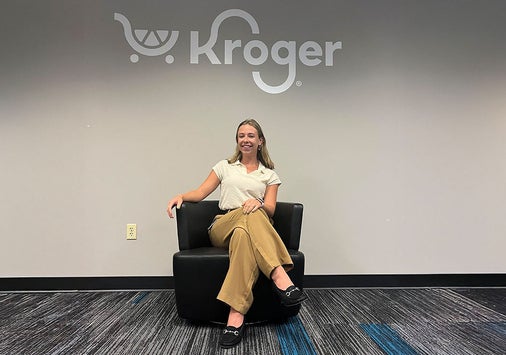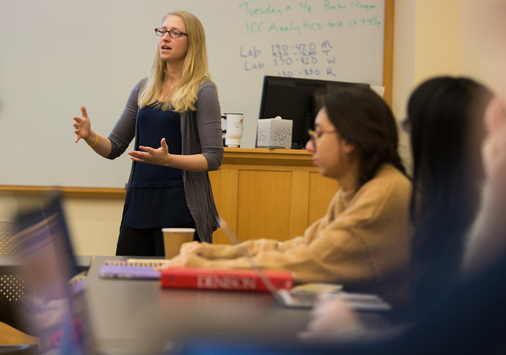Courses
For more information, visit the course planning page.
2025 - 2026
For this academic year's course catalog, please visit our Academic Catalog site. For courses currently offered, please refer to the Schedule of Classes.
This 0-credit course, summer internship, or experience, is required for all DA majors. This experience must be approved by the Data Analytics Program Committee and is normally undertaken during the summer before the senior year.
Many of the most pressing problems in the world can be addressed with data. We are awash in data and modern citizenship demands that we become literate in how to interpret data, what assumptions and processes are necessary to analyze data, as well as how we might participate in generating our own analyses and presentations of data. Consequently, data analytics is an emerging field with skills applicable to a wide variety of disciplines. This course introduces analysis, computation, and presentation concerns through the investigation of data driven puzzles in wide array of fields – political, economic, historical, social, biological, and others. No previous experience is required.
A general category used only in the evaluation of transfer credit.
The Data Analytics colloquium involves three central learning components. 1) regular engagement with guest presentations and community activities in data analytics, 2) group discussion featuring critical analysis and connection of themes found in the guest presentations and in related data analytics topics, and 3) preparation and refinement of professional communication skills necessary for the required internship component of the data analytics major. This course provides an opportunity for students to connect on data analytics ideas and applications, using a range of perspectives that may or may not be normally encountered in a traditional course. Students will develop the knowledge, skills, and methods they need to progress to more advanced learning, while also creating bridges with members of the data analytics community within and outside of Denison. The course must be taken twice by majors: once as a sophomore, and again as either a junior or senior.
Prerequisite(s): DA 101 (may be taken concurrently).
This course provides a broad perspective on the access, structure, storage, and representation of data. It encompasses traditional database systems, but extends to other structured and unstructured repositories of data and their access/acquisition in a client-server model of Internet computing. Also developed are an understanding of data representations amenable to structured analysis, and the algorithms and techniques for transforming and restructuring data to allow such analysis.
Prerequisite(s): CS 109 or CS 111 or CS 112 or CS 113 or CS 114.
Crosslisting: CS 181.
Statistics is the science of reasoning from data. This course will introduce the fundamental concepts and methods of statistics using calculus-based probability. Topics include a basic study of probability models, sampling distributions, confidence intervals, hypothesis testing, categorical data analysis, ANOVA, multivariate regression analysis, logistic regression, and other statistical methods. Scopes of conclusion, model building and validation principles, and common methodological errors are stressed throughout.
Prerequisite(s): Either MATH 145 or both MATH 135 and DA 101.
Crosslisting: MATH 220.
This course provides a venue to explore intermediate topics in Data. Topics courses will vary in content according to the interests of the faculty offering the course and possibly to introduce new classes into the curriculum. Courses at this level should be appropriate for students with introductory work in DA and/or related courses.
Data visualization turns data and analysis into something people can see, and something they can comprehend. The practice of data visualization is built on the science of perception and the art of visual metaphors. While data visualization is a skillset demanded of any role involving data and analytics, there is also a field of study and discipline dedicated to the design and creation of graphical representations of data. This course introduces the discipline of data visualization, design principles and theory, and the way data visualization is used in a variety of fields. As part of this course, you will create and refine your own portfolio of dashboards and infographics, and learn to evaluate data visualization through workshops involving peer-to-peer feedback.
Prerequisite(s): DA 101.
This course is a problem-driven, technically informed engagement with the ethics of data and information as well as an investigation of the moral dimensions of collecting, analyzing, and protecting data. It aims to equip students with the ethical frameworks and philosophical tools necessary to effectively engage with the urgent questions posed by data-driven technology in its various forms. Students will hone their understanding of the ethics of surveillance, scientific research, algorithmic bias, and policy decision-making. We will also investigate how familiar moral notions like privacy, property, fairness, and equality are challenged or illuminated by computational tools and the advent of novel possibilities for data collection and analysis. Projects in the course will seek to put into practice the ethical principles and moral theories in hopes of tackling data-driven decisions prudently and permissibly.
Analyzing Linguistic Data is a course for students interested in analytical approaches (both quantitative and qualitative) to language. The goals are effectively twofold: to introduce students to the subdisciplines of Linguistics and to give students the tools to approach the analysis of those subfields. To further these goals, students will become familiar with RStudio, PRAAT (program for phonetic analysis), online syntactic corpora (in the Penn family), and other related programs/web resources. This will be accomplished with a weekly laboratory session, where students will use the aforementioned programs to understand linguistic problems. Part of these laboratory assignments will involve a creative production component in which students will be asked to creatively display the data that they work with. Additionally, with each laboratory assignment, students are expected to reflect on what the laboratory assignment entailed and to express in words how the laboratory assignment provides insight into the study of language and what potential consequences might be for those interested in the study of language.
Crosslisting: DH 281.
A general category used only in the evaluation of transfer credit.
Utilizing Denison as a model of society, this practicum will explore questions of collective import through the analysis of new and existing sources of data. A problem-driven approach will lead to the acquisition of new, appropriate data analytic skills, set in an ethical context that carefully considers the implications of data display and policy recommendations on community members. A significant component of the course is working in teams to collect and analyze new data to address a puzzle or problem for a real client. Groups or organizations that serve as clients may come from the campus community, local non-profits, or businesses and groups across the region or country. The practicum also develops exposure to policymaking, implementing data driven insights, program management theory, interacting with leaders and professionals, and developing presentation skills appropriate for professional communication with the public. Though a significant learning opportunity itself, this course should also be seen as a prelude to a community internship or research experience in the post-junior year summer. Students should be aware that some off-campus travel may be necessary to meet with specific clients as necessary. Final presentations to the client, in lieu of a scheduled exam, requires flexibility and scheduling outside of the exam schedule.
Prerequisite(s): DA 101, DA 210 and DA 220, or consent of instructor.
This course provides a venue to explore advanced topics in Data. Topics courses will vary in content according to the interests of the faculty offering the course and possibly to introduce new classes into the curriculum. Courses at this level should be appropriate for students with significant work in DA and/or related courses and may require other prerequisites.
This course is designed to develop students' understanding of the cutting-edge methods and algorithms of data analytics and how they can be used to answer questions about real-world problems. These methods can learn from existing data to make and evaluate predictions. The course will examine both supervised and unsupervised methods and will include topics such as dimensionality reduction, machine learning techniques, handling missing data, and prescriptive analytics.
Prerequisite(s): DA 210 and DA 220 or consent of instructor.
Advanced Descriptive Methods (DA 351), in parallel with DA 352 and 353, is designed to develop students' understanding of the cutting-edge methods and algorithms of data analytics and how they can be used to answer questions about real-world problems. While all advanced methods for Data Analytics can be applied in a variety of capacities, descriptive analytics emphasizes using natural language processing (NLP) methods to work with text as data, modeling for interpretability, and designing and deploying computer vision systems. In DA 351 students will examine both supervised and unsupervised methods, including topics such as advanced regression, K nearest neighbors, hierarchical clustering, ranked cosine similarity, and deep learning.
Prerequisite(s): DA 210 or CS 181 and MATH 220 or DA 220.
Advanced Predictive Methods (DA 352), in parallel with DA 351 and 353, is designed to develop students' understanding of the cutting-edge methods and algorithms of data analytics and how they can be used to answer questions about real-world problems. While all advanced methods for Data Analytics can be applied in a variety of capacities, predictive methods emphasize learning from existing data to make predictions about new data. In DA 352 students will examine both supervised and unsupervised methods and will include topics such as clustering, classification, and network analysis.
Prerequisite(s): DA 210 or CS 181 and DA 220 or MATH 220.
Advanced Prescriptive Methods (DA 353), in parallel with DA 351 and 352, is designed to develop students' understanding of the cutting-edge methods and algorithms of data analytics and how they can be used to answer questions about real-world problems. While all advanced methods for Data Analytics can be applied in a variety of capacities, prescriptive analytics emphasizes formulating decision criteria, using data to identify optimal actions, and balancing benefits and tradeoffs of different solutions. In DA 353 students will examine both supervised and unsupervised methods and will include topics such as optimization and linear programming, reinforcement learning, simulation, and decision analysis.
Prerequisite(s): DA 210/CS 181; DA 220/MATH 220.
A student in good standing may work intensively in areas of special interest under the Directed Study plan. A Directed Study is appropriate when, under the guidance of a faculty member, a student wants to explore a subject more fully than is possible in a regular course or to study a subject not covered in the regular curriculum. A Directed Study should not normally duplicate a course that is regularly offered. Directed Studies are normally taken for 3 or 4 credits. A one-semester Directed Study is limited to a maximum of 4 credit hours. Note: Directed Studies may not be used to fulfill General Education requirements.
A student in good standing may work intensively in areas of special interest under the Directed Study plan. A Directed Study is appropriate when, under the guidance of a faculty member, a student wants to explore a subject more fully than is possible in a regular course or to study a subject not covered in the regular curriculum. A Directed Study should not normally duplicate a course that is regularly offered. Directed Studies are normally taken for 3 or 4 credits. A one-semester Directed Study is limited to a maximum of 4 credit hours. Note: Directed Studies may not be used to fulfill General Education requirements.
Independent Study engages a student in the pursuit of clearly defined goals. In this effort a student may employ skills and information developed in previous course experiences or may develop some mastery of new knowledge or skills. A proposal for an Independent Study project must be approved in advance by the faculty member who agrees to serve as the project advisor. Note: Independent Studies may not be used to fulfill General Education requirements.
Independent Study engages a student in the pursuit of clearly defined goals. In this effort a student may employ skills and information developed in previous course experiences or may develop some mastery of new knowledge or skills. A proposal for an Independent Study project must be approved in advance by the faculty member who agrees to serve as the project advisor. Note: Independent Studies may not be used to fulfill General Education requirements.
A general category used only in the evaluation of transfer credit.
This is a capstone seminar for the Data Analytics major in which students work on independent research projects in a collaborative seminar setting. Problems may derive from internship experiences, courses of study at Denison, or another source subject to instructor approval. Heavy emphasis will be placed on providing ongoing research reports and collective problem solving and review.
Students may enroll in Senior Research in their final year at Denison. Normally, Senior Research requires a major thesis, report, or project in the student's field of concentration and carries eight semester-hours of credit for the year. Typically, a final grade for a year-long Senior Research will not be assigned until the completion of the year-long Senior Research at the end of the second semester. In which case, the first semester Senior Research grade will remain "in progress" (PR) until the completion of the second semester Senior Research. Each semester of Senior Research is limited to a maximum of 4 credit hours. Note: Senior Research may not be used to fulfill General Education requirements.
Students may enroll in Senior Research in their final year at Denison. Normally, Senior Research requires a major thesis, report, or project in the student's field of concentration and carries eight semester-hours of credit for the year. Typically, a final grade for a year-long Senior Research will not be assigned until the completion of the year-long Senior Research at the end of the second semester. In which case, the first semester Senior Research grade will remain "in progress" (PR) until the completion of the second semester Senior Research. Each semester of Senior Research is limited to a maximum of 4 credit hours. Note: Senior Research may not be used to fulfill General Education requirements.












